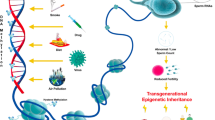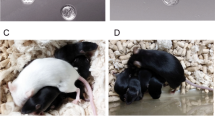Abstract
Purpose
Extracellular vesicles (EVs) secreted by the epididymal epithelium transfer key factors to maturing spermatozoa. Using an in vitro system previously developed in our laboratory, the objective was to (1) characterize the impact of EV exposure on the fertilizing ability and developmental potential of immature sperm cells from the caput epididymidis and (2) examine the benefit of EV exposure to restore vitality of mature spermatozoa from the cauda epididymidis after freezing-thawing.
Methods
EVs were isolated from entire epididymides and collected into pellets via ultracentrifugation. Immature spermatozoa from adult cats were isolated from the caput epididymis and incubated with EVs prior to in vitro fertilization. Similarly, mature spermatozoa were isolated from the cauda segment and cryopreserved prior to EV exposure and subsequent analysis of motility and developmental potential after fertilization.
Results
EV exposure did not affect the percentage of caput sperm penetration; however, it improved the fertilizing ability (faster pronuclear apposition) and the developmental potential (higher proportions of morula-blastocysts) of those immature sperm cells. While EV exposure was beneficial to the frozen-thawed sperm motility, it did not significantly improve the fertilizing ability and the developmental potential.
Conclusions
Epididymal EVs contain multiple factors contributing to immature sperm function, specifically enhancing the ability to complete a faster pronuclear apposition with subsequently improved early embryonic development. Supplementation was also beneficial to the motility of spermatozoa that had undergone cryopreservation. Those new findings could lead to new options for male fertility treatment in animal models and humans.







Similar content being viewed by others
References
Dacheux J-L, Dacheux F. New insights into epididymal function in relation to sperm maturation. Reproduction. 2014;147(2):R27–42.
Sullivan R, Belleannée C. Role of the epididymis in sperm maturation. In: The Sperm Cell: Production, Maturation, Fertilization, Regeneration; 2017.
Kuo YW, Li SH, Maeda K, Gadella BM, Tsai PS. Roles of the reproductive tract in modifications of the sperm membrane surface. J Reprod Dev. 2016;62(4):337–43. https://doi.org/10.1262/jrd.2016-028.
Comizzoli P, Wildt DE, Pukazhenthi BS. Poor centrosomal function of cat testicular spermatozoa impairs embryo development in vitro after intracytoplasmic sperm injection. Biol Reprod. 2006;75(2):252–60. https://doi.org/10.1095/biolreprod.106.051342.
Rowlison T, Ottinger MA, Comizzoli P. Deciphering the mechanisms involving cenexin, ninein and centriolin in sperm maturation during epididymal transit in the domestic cat. Reprod Domest Anim. 2017;52(Suppl 2):193–6. https://doi.org/10.1111/rda.12831.
Nicander L, Malmqvist M. Ultrastructural observations suggesting merocrine secretion in the initial segment of the mammalian epididymis. Cell Tissue Res. 1977;184(4):487–90. https://doi.org/10.1007/BF00220971.
Hermo L, Jacks D. Nature's ingenuity: bypassing the classical secretory route via apocrine secretion. Mol Reprod Dev. 2002;63(3):394–410. https://doi.org/10.1002/mrd.90023.
Sullivan R, Frenette G, Girouard J. Epididymosomes are involved in the acquisition of new sperm proteins during epididymal transit. Asian J Androl. 2007;9(4):483–91. https://doi.org/10.1111/j.1745-7262.2007.00281.x.
Griffiths GS, Galileo DS, Reese K, Martin-DeLeon PA. Investigating the role of murine epididymosomes and uterosomes in GPI-linked protein transfer to sperm using SPAM1 as a model. Molecul Reprod Develop: Incorpor Gamete Res. 2008;75(11):1627–36.
Girouard J, Frenette G, Sullivan R. Comparative proteome and lipid profiles of bovine epididymosomes collected in the intraluminal compartment of the caput and cauda epididymidis. Int J Androl. 2011;34(5 Pt 2):e475–86. https://doi.org/10.1111/j.1365-2605.2011.01203.x.
Sullivan R, Saez F. Epididymosomes, prostasomes, and liposomes: their roles in mammalian male reproductive physiology. Reproduction. 2013;146(1):R21–35.
Zhou W, De Iuliis GN, Dun MD, Nixon B. Characteristics of the epididymal luminal environment responsible for sperm maturation and storage. Front Endocrinol (Lausanne). 2018;9:59. https://doi.org/10.3389/fendo.2018.00059.
Rowlison T, Ottinger MA, Comizzoli P. Key factors enhancing sperm fertilizing ability are transferred from the epididymis to the spermatozoa via epididymosomes in the domestic cat model. J Assist Reprod Genet. 2018;35(2):221–8.
Nixon B, De Iuliis GN, Hart HM, Zhou W, Mathe A, Bernstein IR, et al. Proteomic profiling of mouse epididymosomes reveals their contributions to post-testicular sperm maturation. Mol Cell Proteomics. 2019;18:S91–S108.
James ER, Carrell DT, Aston KI, Jenkins TG, Yeste M, Salas-Huetos A. The role of the epididymis and the contribution of epididymosomes to mammalian reproduction. Int J Mol Sci. 2020;21(15):5377.
Rowlison T, Cleland TP, Ottinger MA, Comizzoli P. Novel proteomic profiling of epididymal extracellular vesicles in the domestic Cat reveals proteins related to sequential sperm maturation with differences observed between normospermic and teratospermic individuals. Mol Cell Proteomics. 2020;19(12):2090–104.
Saez F, Frenette G, Sullivan R. Epididymosomes and prostasomes: their roles in posttesticular maturation of the sperm cells. J Androl. 2003;24(2):149–54.
Rejraji H, Vernet P, Drevet JR. GPX5 is present in the mouse caput and cauda epididymidis lumen at three different locations. Molecul Reprod Develop: Incorpor Gamete Res. 2002;63(1):96–103.
Fornes MW, Barbieri A, Cavicchia JC. Morphological and enzymatic study of membrane-bound vesicles from the lumen of the rat epididymis. Andrologia. 1995;27(1):1–5. https://doi.org/10.1111/j.1439-0272.1995.tb02087.x.
Légaré C, Bérubé B, Boué F, Lefièvre L, Morales CR, El-Alfy M, et al. Hamster sperm antigen P26h is a phosphatidylinositol-anchored protein. Molecul Reprod Develop: Incorpor Gamete Res. 1999;52(2):225–33.
Frenette G, Sullivan R. Prostasome-like particles are involved in the transfer of P25b from the bovine epididymal fluid to the sperm surface. Mol Reprod Dev. 2001;59(1):115–21. https://doi.org/10.1002/mrd.1013.
Thimon V, Koukoui O, Calvo E, Sullivan R. Region-specific gene expression profiling along the human epididymis. Mol Hum Reprod. 2007;13(10):691–704. https://doi.org/10.1093/molehr/gam051.
Thimon V, Frenette G, Saez F, Thabet M, Sullivan R. Protein composition of human epididymosomes collected during surgical vasectomy reversal: a proteomic and genomic approach. Hum Reprod. 2008;23(8):1698–707.
Morales A, Cavicchia J. Release of cytoplasmic apical protrusions from principal cells of the cat epididymis, an electron microscopic study. Tissue Cell. 1991;23(4):505–13.
Belleannee C, Legare C, Calvo E, Thimon V, Sullivan R. microRNA signature is altered in both human epididymis and seminal microvesicles following vasectomy. Hum Reprod. 2013;28(6):1455–67.
Belleannée C, Calvo É, Caballero J, Sullivan R. Epididymosomes convey different repertoires of microRNAs throughout the bovine epididymis. Biol Reprod. 2013;89(2):30 31-11.
Reilly JN, McLaughlin EA, Stanger SJ, Anderson AL, Hutcheon K, Church K, et al. Characterisation of mouse epididymosomes reveals a complex profile of microRNAs and a potential mechanism for modification of the sperm epigenome. Sci Rep. 2016;6(1):31794. https://doi.org/10.1038/srep31794.
Navara C, First N, Schatten G. Phenotypic variations among paternal centrosomes expressed within the zygote as disparate microtubule lengths and sperm aster organization: correlations between centrosome activity and developmental success. Proc Natl Acad Sci. 1996;93(11):5384–8.
Schatten H, Sun QY. The role of centrosomes in mammalian fertilization and its significance for ICSI. Mol Hum Reprod. 2009;15(9):531–8. https://doi.org/10.1093/molehr/gap049.
Schatten G. The centrosome and its mode of inheritance: the reduction of the centrosome during gametogenesis and its restoration during fertilization. Dev Biol. 1994;165(2):299–335. https://doi.org/10.1006/dbio.1994.1256.
Krawetz SA. Paternal contribution: new insights and future challenges. Nat Rev Genet. 2005;6(8):633–42. https://doi.org/10.1038/nrg1654.
Comizzoli P, Wildt DE. Centrosomal functions and dysfunctions in cat spermatozoa. In: The Centrosome: Springer; 2012. p. 49–58.
Manandhar G, Schatten H, Sutovsky P. Centrosome reduction during gametogenesis and its significance. Biol Reprod. 2005;72(1):2–13. https://doi.org/10.1095/biolreprod.104.031245.
Pope C, Turner J, Quatman S, Dresser B. Semen storage in the domestic felid: a comparison of cryopreservation methods and storage temperatures. Biol Reprod. 1991;44(Suppl. 1):117.
Comizzoli P, Wildt DE. On the horizon for fertility preservation in domestic and wild carnivores. Reprod Domest Anim. 2012;47(Suppl 6):261–5. https://doi.org/10.1111/rda.12010.
Pukazhenthi B, Spindler R, Wildt D, Bush LM, Howard J. Osmotic properties of spermatozoa from felids producing different proportions of pleiomorphisms: influence of adding and removing cryoprotectant. Cryobiology. 2002;44(3):288–300. https://doi.org/10.1016/s0011-2240(02)00035-4.
Zambelli D, Caneppele B, Castagnetti C, Belluzzi S. Cryopreservation of cat semen in straws: comparison of five different freezing rates. Reprod Domest Anim. 2002;37(5):310–3. https://doi.org/10.1046/j.1439-0531.2002.00365.x.
Kumar A, Prasad J, Srivastava N, Ghosh S. Strategies to minimize various stress-related freeze–thaw damages during conventional cryopreservation of mammalian spermatozoa. Biopreserv Biobank. 2019;17(6):603–12.
Théry C, Witwer KW, Aikawa E, Alcaraz MJ, Anderson JD, Andriantsitohaina R, et al. Minimal information for studies of extracellular vesicles 2018 (MISEV2018): a position statement of the International Society for Extracellular Vesicles and update of the MISEV2014 guidelines. J Extracell Vesicl. 2018;7(1):1535750.
Nestle E, Graves-Herring J, Keefer C, Comizzoli P. Source of protein supplementation during in vitro culture does not affect the quality of resulting blastocysts in the domestic cat. Reprod Domest Anim. 2012;47:152–5.
Chemes HE, Puigdomenech ET, Carizza C, Olmedo SB, Zanchetti F, Hermes R. Acephalic spermatozoa and abnormal development of the head-neck attachment: a human syndrome of genetic origin. Hum Reprod. 1999;14(7):1811–8. https://doi.org/10.1093/humrep/14.7.1811.
Rawe VY, Terada Y, Nakamura S, Chillik CF, Olmedo SB, Chemes HE. A pathology of the sperm centriole responsible for defective sperm aster formation, syngamy and cleavage. Hum Reprod. 2002;17(9):2344–9. https://doi.org/10.1093/humrep/17.9.2344.
Gaglio T, Saredi A, Compton DA. NuMA is required for the organization of microtubules into aster-like mitotic arrays. J Cell Biol. 1995;131(3):693–708.
Silber S, Escudero T, Lenahan K, Abdelhadi I, Kilani Z, Munne S. Chromosomal abnormalities in embryos derived from testicular sperm extraction. Fertil Steril. 2003;79(1):30–8. https://doi.org/10.1016/s0015-0282(02)04407-2.
Esteves SC, Roque M, Garrido N. Use of testicular sperm for intracytoplasmic sperm injection in men with high sperm DNA fragmentation: a SWOT analysis. Asian J Androl. 2018;20(1):1–8.
Pukazhenthi B, Pelican K, Wildt D, Howard J. Sensitivity of domestic cat (Felis catus) sperm from normospermic versus teratospermic donors to cold-induced acrosomal damage. Biol Reprod. 1999;61(1):135–41. https://doi.org/10.1095/biolreprod61.1.135.
Kim YH, Haidl G, Schaefer M, Egner U, Mandal A, Herr JC. Compartmentalization of a unique ADP/ATP carrier protein SFEC (Sperm Flagellar Energy Carrier, AAC4) with glycolytic enzymes in the fibrous sheath of the human sperm flagellar principal piece. Dev Biol. 2007;302(2):463–76. https://doi.org/10.1016/j.ydbio.2006.10.004.
Piomboni P, Focarelli R, Stendardi A, Ferramosca A, Zara V. The role of mitochondria in energy production for human sperm motility. Int J Androl. 2012;35(2):109–24. https://doi.org/10.1111/j.1365-2605.2011.01218.x.
Bansal SK, Gupta N, Sankhwar SN, Rajender S. Differential genes expression between fertile and infertile spermatozoa revealed by transcriptome analysis. PLoS One. 2015;10(5):e0127007.
D'Amours O, Frenette G, Bordeleau LJ, Allard N, Leclerc P, Blondin P, et al. Epididymosomes transfer epididymal sperm binding protein 1 (ELSPBP1) to dead spermatozoa during epididymal transit in bovine. Biol Reprod. 2012;87(4):94. https://doi.org/10.1095/biolreprod.112.100990.
Slattery ML, Pellatt DF, Mullany LE, Wolff RK. Differential gene expression in colon tissue associated with diet, lifestyle, and related oxidative stress. PLoS One. 2015;10(7):e0134406. https://doi.org/10.1371/journal.pone.0134406.
Han S, Wang Y, Ma J, Wang Z, Wang HD, Yuan Q. Sulforaphene inhibits esophageal cancer progression via suppressing SCD and CDH3 expression, and activating the GADD45B-MAP2K3-p38-p53 feedback loop. Cell Death Dis. 2020;11(8):713. https://doi.org/10.1038/s41419-020-02859-2.
Zhong W, Zhu H, Sheng F, Tian Y, Zhou J, Chen Y, et al. Activation of the MAPK11/12/13/14 (p38 MAPK) pathway regulates the transcription of autophagy genes in response to oxidative stress induced by a novel copper complex in HeLa cells. Autophagy. 2014;10(7):1285–300. https://doi.org/10.4161/auto.28789.
Zhou R, Tardivel A, Thorens B, Choi I, Tschopp J. Thioredoxin-interacting protein links oxidative stress to inflammasome activation. Nat Immunol. 2010;11(2):136–40. https://doi.org/10.1038/ni.1831.
Fernando MR, Nanri H, Yoshitake S, Nagata-Kuno K, Minakami S. Thioredoxin regenerates proteins inactivated by oxidative stress in endothelial cells. Eur J Biochem. 1992;209(3):917–22.
Acknowledgements
We would like to thank Dr. Brent Whitaker (Animal Rescue, Inc.) as well as Dr. Keiko Antoku and their staff for providing domestic cat ovaries and testes.
Funding
This study was funded by Smithsonian’s Scholarly Studies Program.
Author information
Authors and Affiliations
Corresponding author
Ethics declarations
Conflict of interest
The authors declare no competing interests.
Additional information
Publisher’s note
Springer Nature remains neutral with regard to jurisdictional claims in published maps and institutional affiliations.
Rights and permissions
About this article
Cite this article
Rowlison, T., Ottinger, M.A. & Comizzoli, P. Exposure to epididymal extracellular vesicles enhances immature sperm function and sustains vitality of cryopreserved spermatozoa in the domestic cat model. J Assist Reprod Genet 38, 2061–2071 (2021). https://doi.org/10.1007/s10815-021-02214-0
Received:
Accepted:
Published:
Issue Date:
DOI: https://doi.org/10.1007/s10815-021-02214-0




